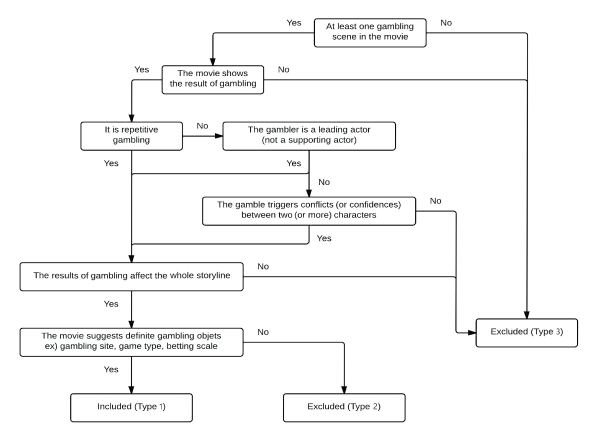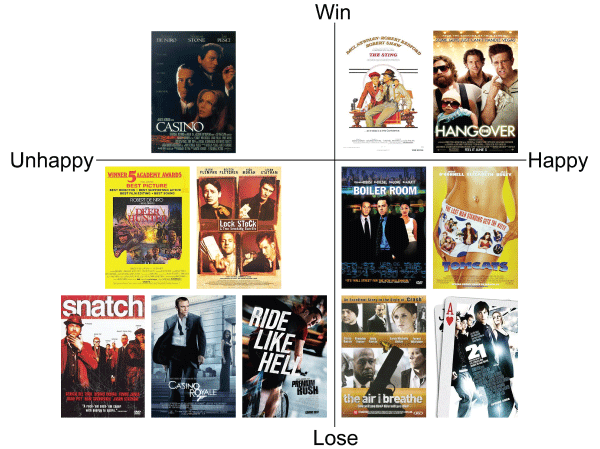Journal of Addiction Medicine and Therapeutic Science
Pathological gambling in motion pictures; A systematic review
Kun Hwang1*, Yong Soon Choi2, Yoo Chan Kim2, Se Jin Hwang5, and Se Ho Hwang5,6
2Medical Student, Inha University School of Medicine, Incheon, Korea
3MBBS, Reconstructive Microsurgery Online MSc, Blizard Institute, Queen Mary University of London, UK
4FY2 Doctor, Leicester Royal Infirmary, Leicester, UK
5MBBS, Reconstructive Microsurgery Online MSc, Blizard Institute, Queen Mary University of London, London, United Kingdom
6FY2 Doctor, Leicester Royal Infirmary, Leicester, United Kingdom
Cite this as
Hwang K, Choi YS, Kim YC, Hwang SJ, Hwang SH (2020) Pathological gambling in motion pictures; A systematic review. J Addict Med Ther Sci 6(1): 064-067. DOI: 10.17352/2455-3484.000041Background: The aim of this study is to analyze the movies of pathologic gambling from comprehensive samples.
Methods: Movies (all 102 titles) related to gambling were collected by keyword search in IMDB (International Movie Database, www.imdb.com). Among them, 16 titles were selected in which the storyline was directly related to gambling, gambling scene was exposed in individual plots, and the result of gambling influenced the development of storyline. The films were reviewed and analyzed.
Results: Protagonists were all males. The reasons why they first started gambling were mostly by temptation (46%). Purpose of their gambling act was to get rich (81%). Most of the gambling sites were casino (31%) or gambling house (25%). Most frequent type of gambling was poker (40%), followed by black jack (13%) and sports gambling (13%). Most of the gambling (63%) was illegal. In 56%, the gaming was temperate and the 42% was impulsive. In 67%, protagonist followed the gambling rule, but in 33%, he ran crooked gambling. In 57%, protagonist did not have any particular advantageous skill for gambling. In 2/3, the protagonist lost the game, won in 1/3. The protagonist was regretful for his gambling act in 45%. In 12 titles of 14 titles, 6 protagonist become happy irrespective of the result (2 win, 4 lose), but 6 became unhappy (1 win, 5 lose) (Odds ratio=2.5).
Conclusion: How these people perceive ‘gambling’, from the exposed media information may be different from reality. We hope the result of this study might be helpful in education of gambling addicts.
Introduction
Gambling is the act of risking the loss of something of value (money) on an uncertain outcome in the hope of winning something of greater value (money). Gambling has often been a popular topic for myths, operas, books, songs, and in recent years, motion pictures [1]. Portrayals in the media undoubtedly have a large impact on how we perceive the world in which we live, especially matters we know little or nothing about [2].
Pathological gambling has been described by the American Psychiatric Association “as a chronic progressive failure to resist impulses to gamble, and gambling behavior that compromises, disrupts, or damages personal, family, or vocational pursuits [3].” Pathological gambling is a social concern that has been portrayed by many moviemakers around the world, although the depth to which films explore the issue varies greatly. The world of gambling and gamblers has been portrayed in many films throughout the years [2].
Irresponsibly happy endings in movies about pathological gambling could encourage problem gambling. It is therefore important to examine the images of gambling presented in films to determine what distortions are present in recent movies.
Turner reviewed 65 films that focused on gambling and he found 8 overlapping themes represented in those movies [1]. Another 2 papers analyzed the main protagonists of 9 and 10 Hong Kong movies, respectively, from a psychological perspective [4,5].
The aim of this study was to analyze movies portraying pathological gambling based on a comprehensive sample.
Methods
Selection of movies portraying gambling
A total of 102 movies related to gambling were collected by a keyword search in the International Movie Database (IMDB; www.imdb.com).
The keywords used were “gambling” (55 titles), “gambling addiction” (7 titles), “gambling debt” (15 titles), “gambling syndicate” (3 titles), “illegal gambling” (4 titles), “gambling casino” (7 titles), and “casino” (11 titles).
Among the 102 movies, 27 were selected in which the storyline was directly related to gambling, and the others (type 3, 75 movies) were excluded. In the 27 selected titles, the movies in which a gambling scene was portrayed as part of the plot and the results of gambling influenced the development of the storyline were included (type 1, 16 movies). The other 11 movies (type 2) were excluded (Figure 1). Sample size for each parameter could vary depending on whether enough information.
The remaining 16 movies selected were focused on the card games.
Analysis of movies
The films were reviewed and analyzed according to the following parameters:
1. Protagonist: age, sex, and occupation of the protagonist
2. Reason and purpose: reason for first becoming involved in gambling and the purpose of gambling.
3. Game: site of gambling, type of gambling, legal or illegal
4. Nature of gambling: moderate or compulsive
5. Cheating: following the rules or a crooked gambling operation
6. Skill of gambling: body language, statistical analysis
7. Betting scale
8. Money: Did the protagonist win or lose money? How did they spend the money they earned?
9. Influence of gambling on human relationships: positive or negative
10. Did the protagonist find that he or she committed a mistake or error?
11. Did the protagonist become happy as a result of gambling?.
Results
1. Country of production: The USA was involved in production of 15 of the 16 movies (USA alone, 11; UK, 2; Czech Republic, 2; Germany, 1; Mexico, 1). One movie was fully made in the UK.
2. Starring role: In 15 of the 16 movies, a Caucasian was cast in the lead role, while an African-American was cast in the other movie.
3. Protagonist: In the 16 movies, the protagonists were all males. Five of them were in their 20s (31%), 8 in their 30s (50%), and 3 in their 40s (19%). Their occupations varied. Two were students, 2 were company workers, and the other protagonists included a police officer and dentist.
4. Reason and purpose: Among the 13 movies for which enough information was presented to assess this parameter, the reasons why the protagonist first started gambling was mostly being tempted (6, 46%). In the full sample of 16 movies, their purpose for gambling was money and to get rich (13, 81%). In 21 and Rounders the students gambled to earn their tuition fees. In The Hangover, a dentist gambled to rescue a kidnapped friend. In only 2 films, the protagonist gambled for revenge (Sting) or honor and love (A Knight’s Tale).
5. Game: Most of the gambling sites were casinos (5 of 16 films, 31%) or gambling houses (4, 25%). The most frequent type of gambling was poker (6 of 15 films, 40%), followed by blackjack (2, 13%) and sports gambling (2, 13%). Among the 16 movies, 10 (63%) portrayed illegal gambling, while only 6 (37%) showed legal gambling.
6. Nature of gambling: In more than half of the films, the gaming was moderate (9 of 16 titles, 56%). In the rest of the titles (7, 42%), the gaming was compulsive.
7. Cheating: In most of the titles (10 of 15 titles, 67%), the protagonist followed the rules of gambling. However, in some movies (5, 33%) the protagonist ran a crooked gambling operation.
8. Skill of gambling: In most cases (8 of 14 titles, 57%), the protagonist did not have any particular advantageous skill in gambling. In 3 movies (Sting, Casino, and Rounders, 33%), the protagonist had an advantageous skill that helped him win. In two titles (21 and The Hangover, 14%), the protagonist used statistical analysis in blackjack games. In one movie (Casino Royale), the protagonist used bluffing.
9. The betting scale ranged from $3000 (The Hustler) to $150,000,000 (Casino Royale).
10. Money: In two-thirds of the cases (10 out of 15 movies, 67%), the protagonist lost the game. In one-third, the protagonist won (5, 33%). They used the earned money to pay off their debts (Rounders), to rescue a friend (The Hangover), or to pay the mafia (Casino).
11. Influence of gambling on human relationships (3 positive and 5 negative effects): Negative aspects were shown in 5 films (the end of the protagonist’s relationship with his mentor in 21, the death of the protagonist in Deer Hunter, falling in love with a trickster in Casino, kidnapping of the winner’s colleague (Vesper) by the host in Casino Royale, and family discord in Boiler Room). Positive effects were portrayed in 3 films (winning over a woman the protagonist loved in 21 and ,em>A Knight’s Tale
, keeping the word he gave to his professor in Rounders).12. Did the protagonist find that he committed a mistake or error? The protagonist regretted gambling in 5 of 11 movies (45%). In 6 movies (55%), the protagonist did not realize his error, and it was shown to be possible for him to gamble again.
13. Did the protagonist become happy as a result of gambling? In 3 movies, the protagonist won at gambling and became happy as a result (30%; Sting, Knight’s Tale, and Rounders). In 2 titles (20%), however, the protagonist died during the game (Deer Hunter) or was murdered as a result (Casino Royale). In 4 movies (40%; 21, The Air I Breathe, Tomcats, and Boiler Room), despite losing money, the protagonist became happy by obtaining wisdom as a result of his failure at gambling.
Table 1 summarizes the results (Table 1).
Discussion
Turner reviewed 65 gambling films and he found 8 overlapping themes represented in those movies: (1) pathological gambling, (2) the magical skill of the professional gambler, (3) miraculous wins as happy endings, (4) gamblers are suckers, (5) gamblers cheat, (6) gambling is run by organized crime, (7) the casino heist, and (8) gambling as a symbolic backdrop to the story [1]. Ohtsuka and Chan analyzed female gamblers in 9 Hong Kong movies and male gamblers in 10 Hong Kong movies [4,5].
Recently Egerer reviewed 72 film scenes from 28 narrative fiction films and analyzed the game types, the Poker Face and Indirect Expression of Emotions, nervous, exaggerated, and brutal between agency and loss of control [6].
Based on Turner’s and Egerer’s parameters, we added 7 detailed parameters: 1. Demography of protagonist; 2. Reason for first becoming involved in gambling and the purpose of gambling; 4. Nature of gambling: moderate or compulsive; 7. Betting scale; 8. Did the protagonist win or lose money? How did they spend the money they earned? 9. Influence of gambling on human relationships: positive or negative; and lastly 10. Did the protagonist find that he or she committed a mistake or error?.
In this paper, movies portraying pathological gambling were analyzed based on a comprehensive sample. Among the 13 movies for which this information was available, the reason why the protagonist first started gambling was mostly being tempted (6, 46%). In most of the films (10 out of 15 films, 67%), the protagonist followed the rules of gambling. The protagonist regretted gambling in 5 of 11 titles (45%). In two-thirds of cases (10 out of 15 movies, 67%), the protagonist lost the game. Only one-third of the protagonists won (5 movies, 33%). In 12 of 14 movies, 6 protagonists (57%) became happy irrespective of the result (2 won, 4 lost). Six became unhappy (1 won, 5 lost) (odds ratio = 2.5; 95% CI, 0.1619- 38.6011, P=.5117). Although not statistically significant, the likelihood of becoming happy was 2.5 times higher when the protagonist won the game than when he lost (Figure 2).
Empirical research on cultural influences on gambling behavior is still scarce, but converging research evidence sheds light on the psychological mechanism that underlies gambling, the risk factors for gambling and protective factors against gambling, and its role in regulating mood. Another line of research has also linked gambling to adjustment stress, the unavailability of other types of leisure activities, and various types of erroneous cognition regarding the odds of winning [5].
Fictional films including gambling do not have to be accurate. However, the producers and distributors should have some responsibility for the content of their films.
Conclusion
Some people may only encounter gambling through movies or other media, not in their actual experiences. How such people perceive gambling based on the information they receive through the media may not correspond to reality.
In most of the movie, even though the protagonist did not won at gambling, and even if he won, showed low possibility of became happy (30%), Moreover, the protagonist died during the game or was murdered as a result (20%). On the contrary, despite losing money, the protagonist became happy by obtaining wisdom as a result of his failure at gambling In 4 movies (40%).
We hope that above results of this study may be helpful for educating gambling addicts.
The authors have no conflict of interests to declare. We are grateful to Hun Kim, BHS, for his help in making figures.
- Turner NE, Fritz B, Zangeneh M (2007) Images of gambling in film. J Gambl Issues 20: 117-144. Link: https://bit.ly/3g9USEF
- Griffiths MD (2004) An empirical analysis of the film, the gambler. Int J Ment Health Addict 1: 39-43. Link: https://bit.ly/34eO0DI
- Lesieur HR, Blume SB (1993) Pathological gambling, eating disorders, and the psychoactive substance use disorders. J Addict Dis 12: 89-102. Link: https://bit.ly/2Ee2mZW
- Ohtsuka K, Chan CC (2009) Desperate housewives: an analysis of the characterisations of female gamblers portrayed in gambling movies in Hong Kong. Int J Ment Health Addict 7: 229-238. Link: https://bit.ly/2E5rna2
- Chan CC, Ohtsuka K (2011) All for the winner: an analysis of the characterization of male gamblers in Hong Kong movies with gambling theme. Int J Ment Health Addict 9: 208–218. Link: https://bit.ly/3iSmvUh
- Egerer M, Rantala V (2015) What makes gambling cool? Images of agency and self-control in fiction films. Subst Use Misuse 50: 468-483. Link: https://bit.ly/2Ft42iL
Article Alerts
Subscribe to our articles alerts and stay tuned.
 This work is licensed under a Creative Commons Attribution 4.0 International License.
This work is licensed under a Creative Commons Attribution 4.0 International License.



 Save to Mendeley
Save to Mendeley
